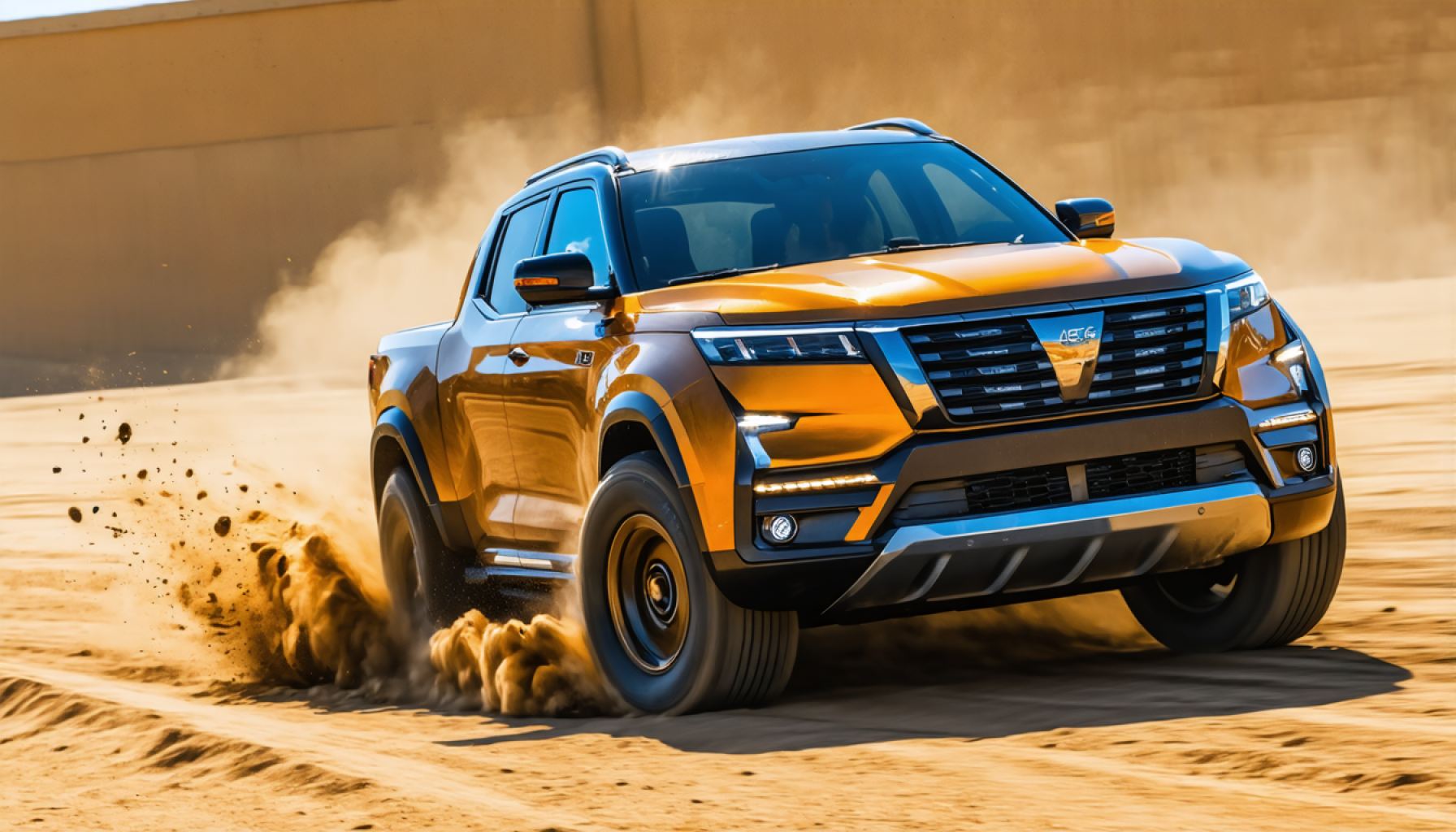- The Hunter PHEV, unveiled at the Melbourne Motor Show, showcases a balance of power and innovation, poised to redefine the ute market in 2026.
- It features a 2.0L turbocharged engine paired with dual electric motors, delivering 385kW of power and 1000Nm of torque, outperforming rivals like the BYD Shark 6 and GWM Cannon Alpha.
- Emphasizing sustainability, the vehicle offers a 100 km battery-only range, blending eco-friendliness with high performance.
- Advanced features include vehicle-to-load (V2L) technology, allowing power supply for tools or electronic devices during outings.
- Design retains subtlety with modern touches, while interior technology includes a digital dashboard and infotainment system.
- Safety features such as autonomous emergency braking and a 360-degree camera enhance driver confidence.
- Set for production by late 2025, the Hunter PHEV marks a shift towards more responsible and adventurous vehicular experiences.
A symphony of raw power and innovation turned heads at the Melbourne Motor Show as JAC introduced its latest marvel, the Hunter PHEV. The stage, lit with the promise of the future, shone brightly on a robust machine that’s as much brawn as it is brains—there’s a beast in the ute market, and it’s setting the tone for 2026.
Envision a creature that moves with relentless vigor, guided by a 2.0L turbocharged inline-four engine, harmoniously working in tandem with dual electric motors. This dynamic duo generates a staggering 385kW of power, along with an earth-shaking torque of 1000Nm. Numbers like these render competitors like the BYD Shark 6 and the GWM Cannon Alpha mere echoes, while even the mighty RAM 1500 TRX takes notice of the newcomer on the PHEV block.
But the Hunter PHEV isn’t just about raw energy and torque that would make a lumberjack blush. It’s a paradigm of sustainability wrapped in a rugged frame, offering a targeted battery-only range of 100 kilometers, making it as kind to the planet as it is audacious on the highways. Picture silently cruising past picturesque landscapes, only to roar into life when the terrain demands it.
JAC engineers have imbued their creation with smarter capabilities too. The ute provides vehicle-to-load (V2L) functionality, posing as a literal powerhouse; imagine charging power tools or running a campsite’s worth of electronics during a serene escape into nature, or keeping the lights on during unexpected power cuts at home.
Externally, the Hunter PHEV doesn’t rely on flamboyance to stand out. Its design remains subtle—a near mirror image of its diesel cousin, the JAC T9—save for subtle cues like sleek alloy wheels and striking red brake calipers hinting at the might beneath. Inside, however, the cabin embraces modernity with a 10.25-inch digital dashboard accompanying the familiar 10.4-inch infotainment interface, ensuring that the driver remains informed and entertained, every turn of the journey.
Safety trimmings like autonomous emergency braking and a panoramic 360-degree camera ensure peace of mind, underscoring JAC’s commitment to technology that protects as effectively as it performs.
Eager for production by late 2025, the Hunter PHEV looks ready to stake its claim early 2026. As JAC prepares to unveil detailed specs and pricing, the industry stands poised to witness the dawn of a new era of power and efficiency, wrapped in the guise of this formidable plug-in hybrid ute.
The Hunter PHEV isn’t just a vehicle; it’s where power meets responsibility, wrapped in the unyielding grip of adventure. As it careens towards Australian shores, it invites us to rethink what our roads—and our environmental consciousness—can hold. As we stand at the cusp of this automotive revolution, one thing is clear: the winds of change are howling fiercely.
New Hybrid Ute Alert: Discover the JAC Hunter PHEV’s Game-Changing Features
Introduction
The JAC Hunter PHEV has made a striking debut at the Melbourne Motor Show, capturing attention with its impressive blend of power and innovation in the plug-in hybrid electric vehicle (PHEV) segment. This article explores additional insights, practical applications, and industry trends related to this formidable vehicle.
Key Features and Specifications
– Powertrain Excellence: Equipped with a 2.0L turbocharged inline-four engine and dual electric motors, the Hunter PHEV generates a commanding 385kW of power and 1000Nm of torque. These numbers surpass many in its class, including the BYD Shark 6 and GWM Cannon Alpha, positioning it as a leader in the PHEV market.
– Sustainability Focus: The PHEV offers a battery-only range of 100 kilometers, allowing for eco-friendly drives that significantly reduce emissions compared to traditional combustion engines. This makes it a responsible choice for environmentally conscious consumers.
– Innovative Capabilities: The vehicle-to-load (V2L) functionality lets the Hunter PHEV serve as a mobile power source, ideal for outdoor adventures or emergency backup power at home.
– Balanced Design: While its design remains understated, the Hunter PHEV features sleek alloy wheels and red brake calipers, contrasting its modest exterior with its robust performance capabilities.
– Advanced Safety: Safety features such as autonomous emergency braking and a panoramic 360-degree camera provide ample protection and enhanced visibility for drivers.
Real-World Applications
1. Off-Road and Adventure Ready: With its powerful torque and V2L capability, the Hunter PHEV is well-suited for camping trips and off-road expeditions, allowing users to power devices and appliances comfortably in remote areas.
2. Urban Commuting: The 100-kilometer EV range is ideal for daily commuting, reducing fossil fuel consumption and lowering running costs while maintaining the flexibility of a hybrid for longer trips.
3. Emergency Preparedness: As a mobile power unit, it offers a practical solution during power outages, supplying electricity for essential household appliances or electronic devices.
Industry Trends and Market Forecast
– Increased Hybrid Demand: With the rising emphasis on sustainability and the gradual shift towards electric vehicles, the demand for PHEVs like the Hunter is expected to grow. This trend aligns with global initiatives to reduce carbon footprints and dependency on fossil fuels.
– Technological Advancements: Continued advancements in battery technology and energy management systems will likely enhance the efficiency and performance of future PHEVs.
Pros and Cons Overview
Pros:
– High power and torque for excellent performance.
– Environmentally friendly with substantial electric-only range.
– Versatile V2L capability for diverse applications.
– Comprehensive safety features.
Cons:
– Pricing and detailed specs are not yet announced, leading to uncertainty about its market positioning.
– Competition from both fully electric vehicles and conventional hybrids could impact its adoption.
Actionable Recommendations
1. Stay Updated: Keep an eye out for JAC’s announcements regarding detailed specifications, pricing, and availability to make an informed purchasing decision.
2. Analyze Your Needs: Consider how the Hunter PHEV’s features align with your driving habits and lifestyle, particularly if you enjoy outdoor activities or need a versatile vehicle.
3. Consider the Environment: Opting for a PHEV like the Hunter contributes to a more sustainable future by reducing emissions while still offering the flexibility of a traditional vehicle.
For more information about innovative vehicle technologies and market insights, visit the official websites of leading automotive manufacturers and industry authorities at JAC and Auto News.










